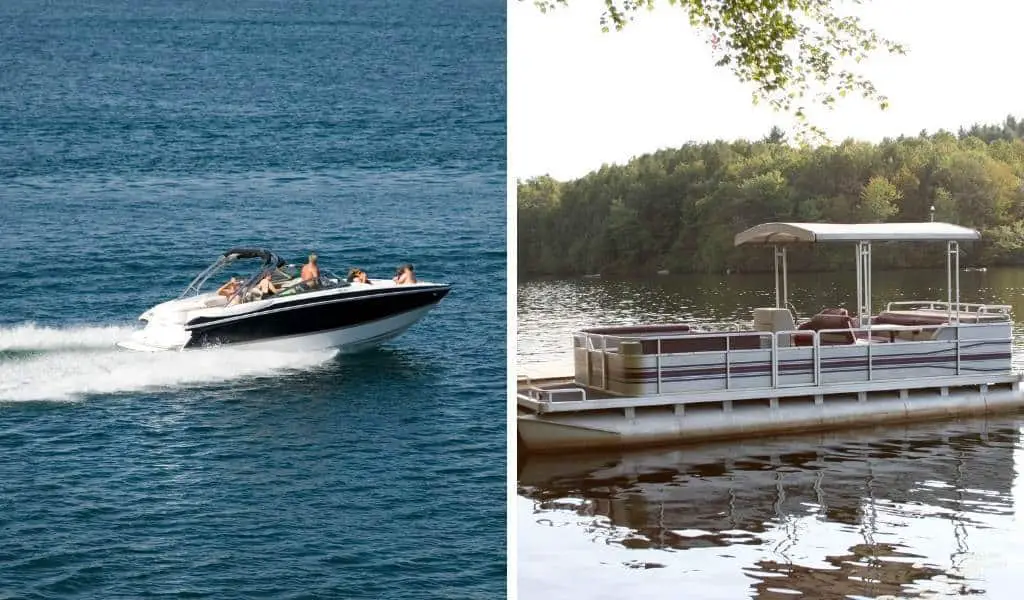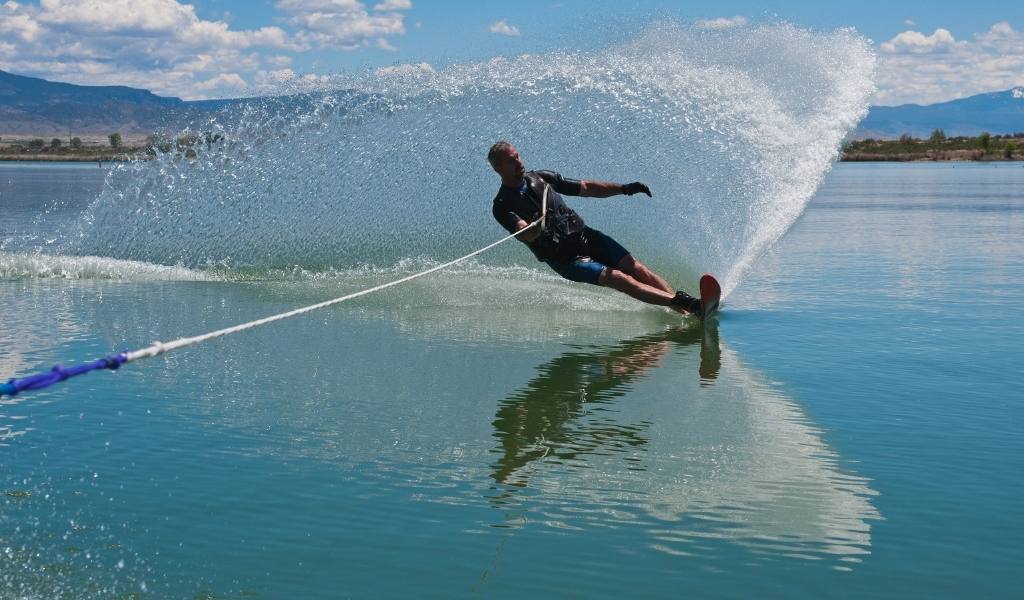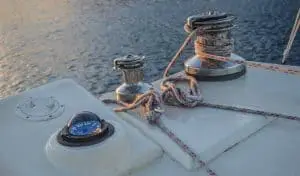Pontoon boats are one of the most versatile watercraft you’ll find. They’re great for a variety of water activities which makes them ideal for families and large groups. Whether you enjoy fishing or cruising, a pontoon boat is going to deliver. Not surprising, they can also be used for skiing as well. It just goes to show how useful pontoon boats can be.
Yes, you can ski behind most pontoon boats, but your engine must be 70 horsepower at a minimum. You won’t have the same experience you’d have with a ski boat, and if you like to do figure 8’s and sharp turns, you’ll be disappointed.
Despite their large size and perceived sluggishness, you can ski behind a pontoon boat. However, not every pontoon boat can pull a skier. A larger engine is required if you want to slalom. In my experience, 70 HP is the bare minimum power you need, and 115 HP will give you a ride similar to a typical ski boat.
If you need a tow bar for your pontoon boat, check out our review of the new Universal Ski Tow Bar from Aerial Wakeboarding.
Can You Ski Behind A Pontoon Boat?
Pontoon boats that have anything less than a 70 HP engine are perfectly suited for cruising or fishing, but not water skiing. This is because an average adult weighs between 130 and 220 pounds, and it takes at least 70 HP to generate enough speed and acceleration, especially during the start. Any less power, and you’ll drag your skier for miles before they get up. In reality, you can only do some basic skiing with a minimally powered boat because it lacks the oomph to do any more than keep you afloat.
If you want to have a group of people on your boat, or you want to do some aggressive water skiing, then you’ll need a boat with at least 90 horsepower. With a 90 HP engine, you can even begin to enjoy some slalom skiing. This seems to be the sweet spot for skiing behind a pontoon boat.
Now, if you really want to get serious and ski like you mean it, then your boat should have an engine rated at 115 HP. This level of power is enough to get you up quickly, regardless of how many people are on the boat. It also gives you the option to ski at higher speeds if you’re looking to jump the wake and catch some air. You’ll find that 115 HP will give you the greatest flexibility to adjust your skiing to the local conditions and offer you some challenging excitement.
Of course, these horsepower numbers may vary depending on the number of people you have onboard, the size of your pontoon boat, or the weight of the skier being pulled. The only way to know for sure is to take your boat out and see what it can do.
How Fast Do You Need To Go?
Generally, your pontoon boat would need to be going at least 16mph before you can ski behind it. At this speed, you’re almost going too slowly to do anything interesting or challenging. A large skier would still be half under and half on top of the water.
Here are the speeds I’ve found to work well for other skiing activities;
- Slalom water skiing requires that your boat is moving at a speed of 25 to 34mph.
- Tubing and wakeboarding don’t require as much speed as slalom water skiing so you would be fine at a speed of 16 to 25 mph.
- Two skiers behind a pontoon boat would need your boat to be going at a speed between 20 and 34mph.
Remember, these are only rules of thumb. Some skiers like to ski hard and fast. Others like to sit back and take in the scenery. Be a good captain (and host), and adjust your speed accordingly.
Problems Skiing Behind a Pontoon Boat
Although you would totally enjoy skiing behind a pontoon boat, there are a few challenges compared to a conventional ski boat that you’re likely to discover:
- Less exciting than a speed boat: The first complication you may be faced with is that pontoon boats don’t stir up enough turbulence to give you that needed edge or excitement to complement your skiing. Without the wake that skiers love (or fear), you can forget about any chance of getting jumps while skiing. This is totally due to the shape of a pontoon boat which creates three very small humps in the water. The V-shaped hulls of speed boats, on the other hand, really do justice to this. It is for this reason that those who take skiing seriously might be disappointed behind a pontoon boat.
- Tight turns are difficult: Another thing that could make you less thrilled with skiing behind a pontoon boat is that they are not designed to make really tight turns. To put it simply, most of your turnings would just be slow, gentle and boring.
- Takes longer to stand up: One more thing that you might find uninteresting about skiing behind a pontoon boat is that its generally low engine horsepower would make sure that it takes you a while before you eventually get to stand up. This may tire you out quickly and you’ll end up going home earlier than you planned.
- Less Competitive: Finally, how fun can a sport be if you can’t actually compete with your friends and show off how good you are? Skiing behind a pontoon boat only allows for fun skiing and doesn’t present many opportunities to engage in competitive skiing with your buddies.
Curious to know if a ski boat is what you need? Read this article.
How to Get Up on Skis With a Pontoon Boat
The biggest challenge I find using my pontoon boat to pull skiers is getting them up and out of the water. Every water skier knows that the hardest part about skiing is getting up. An under-powered boat can’t get up to speed fast enough for you to rise up out of the water. This results in being dragged through the water – half in and half out – for what can seem like miles.
Dragging a skier makes them feel like they’re drowning because they’re mostly submerged. It’s also extremely tiring because the resistance through the water is tremendous – your skis are mostly vertical, which makes them feel like an open parachute. Many skiers struggle to keep their legs bent with the skis pointing forward. Beginners don’t do well behind a boat with a small engine.
The trick to getting up behind a pontoon boat is to take your time and be patient. I tell my skiers to keep their knees bent with their legs up against their chest until they’re completely out of the water. By keeping your legs against your body, you gain a lot of stability, which helps keep your skis pointing straight. It also takes a lot less energy because you’re not fighting against the rush of water coming towards you.
If you stand up too soon (before the boat is up to speed), you’re skis will sink into the water. This will cause the water to “grab” your skis, which can cause you to fly over the top of your skis.
The trick to skiing behind a pontoon boat is to stay in a tuck position until your up and riding on top of the water. Don’t stand up until you’ve gone at least 100 yards.
Related Article: Complete Guide to Water Skiing
Slalom Skiing Behind a Pontoon Boat
If you’ve been skiing for a while, chances are you prefer slaloming to two skis. I do.
The biggest challenges with slalom skiing behind a pontoon boat are acceleration and speed. Acceleration – how quickly your boat can get to the required speed – is very important when you’re skiing. It’s even more important for slalom skiing because it’s a lot harder to get up on one ski. Once you get up, you need to go faster than you would on two skis. Pontoon boats make this difficult because they are larger than a ski boat.
I always have my slalom skiers get up on two skis and drop one. Most people learned to slalom by dropping a ski, so this shouldn’t be a new skill. If you’ve never dropped a ski, it’s pretty simple. Put your slalom ski on like normal. Use a second ski on your back foot to help you get up. The binding should be set on the loosest setting that allows you to keep the boot on. Once you’re up on two skis (read the section above for how to get up on two skis), signal to the captain that you’re going to drop the ski. The spotter should check for landmarks so you can retrieve the ski later.
Once your up on one ski, you’ll have to signal to the captain if the speed is good or not. Some pontoon boats can’t go as fast as you need for slalom skiing, so you may find you’re have under and half on top of the water. If this is the case, you may be better off using two skis.
Check out this video demonstrating how much engine power it takes to ski behind a pontoon boat.
Pontoon Boat Vs Ski Boat

So far, you should already know that you can water ski behind a pontoon boat to a considerable extent. But you can be certain that skiing behind a ski boat is super different and is much preferred by a significant number of people. Here are some of the reasons for this:
- It takes a longer time to get up behind a pontoon boat than it takes when you are behind a ski boat. Ski boats are powerful enough to quickly get you to speeds suitable for water skiing while pontoon boat would be quite sluggish in doing so.
- The fact that pontoon boats have lesser maneuverability than ski boats makes skiing behind them quite slow. One thing that we always love about water skiing behind a ski boat is when we are being thrown to every side by the sharp turnings of the boat. Pontoon boats, unfortunately, don’t have this perk.
- Due to the shape of a pontoon boat, the amount of turbulence it leaves in its wake is so low that it wouldn’t offer you many opportunities to make thrilling jumps when skiing. Ski boats, on the other hand, would offer you many opportunities to do this.
- Also, if you are looking for a really thrilling and exciting skiing experience, pontoon boats aren’t your best bet as they mostly go in straight lines without many tight turns. Even when they make their turnings, they do it pretty slow and gently too so that it doesn’t seem to be really different from when they are going straight.
How to Stay Safe
Hey! We’re trying to have some fun skiing and not get injured or worse, killed. That is why safety is really important when skiing.
- The first way to stay safe is by wearing a United States Coast Guards (USCG) approved life vest. This is especially important for those who aren’t good swimmers.
- Always have a spotter on the boat. Most states require this by law. Regardless, a spotter is the safest way to keep an eye on your skier while your driving the boat.
- If you’re driving the pontoon boat, never go at a speed that’s too fast for the skier to handle. You should even slow down some more if you are pulling a kid.
- It is not safe to ski in crowded areas. You could get yourself or others injured.
- Some hand signals have been developed to help you communicate with others while you’re skiing. It would be great to learn these hand signals because you never know when you may need them.
Conclusion
To be honest, skiing behind pontoon boats may not as thrilling as skiing behind a ski boat. But trust me, you would still have yourself a nice time skiing. Just make sure you stay safe and enjoy yourself. That’s all that matters after all.




